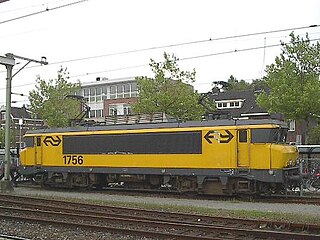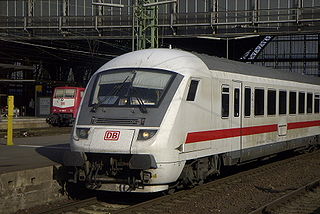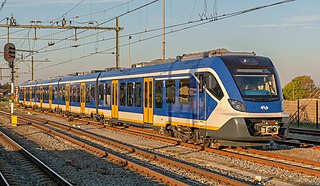
The Siemens Desiro is a family of diesel or electric multiple unit passenger trains developed by Siemens Mobility, a division of the German Siemens AG conglomerate. The main variants are the Desiro Classic, Desiro ML, Desiro UK and the later Desiro City, Desiro HC and Desiro RUS. The trains are mostly used for commuter and regional services, and their rapid acceleration makes them suitable for services with short distances between stations. The design is flexible, and has become common in many European countries.

A bilevel car or double-decker coach is a type of railcar that has two levels of passenger accommodation, as opposed to one, increasing passenger capacity.

The British Rail Mark 3 is a type of passenger carriage developed in response to growing competition from airlines and the car in the 1970s. A variant of the Mark 3 became the rolling stock for the High Speed Train (HST).

The Nederlandse Spoorwegen (NS) Class 1700 is a class of electric locomotives built by Alstom in 1990-1994.

The NS Class 1600 is a type of B′B′ electric locomotive built by Alstom between 1980 and 1983 based on the SNCF Class BB 7200, and in use by the Dutch Railways since 1981. They were styled by the French industrial designer Paul Arzens.

A control car, cab car, control trailer, or driving trailer is a non-powered rail vehicle from which a train can be operated. As dedicated vehicles or regular passenger cars, they have one or two driver compartments with all the controls and gauges required to remotely operate the locomotive, including exterior locomotive equipment such as horns, bells, ploughs, and lights. They also have communications and safety systems such as GSM-R or European Train Control System (ETCS). Control cars enable push-pull operation when located on the end of a train opposite its locomotive by allowing the train to reverse direction at a terminus without moving the locomotive or turning the train around.

British Rail Class 93 is the traction classification assigned to the electric locomotives that were to enter service as part of British Rail (BR)'s InterCity 250 project on the West Coast Main Line (WCML). They would have been capable of travelling at up to 155 mph (250 km/h), and powering a push-pull train of up to nine Mark 5 coaches and a driving van trailer (DVT), similar to the InterCity 225 sets.

The Class 81 is the first and oldest type of electric multiple unit introduced by Keretapi Tanah Melayu for its KTM Komuter service. 18 sets were designed by Hunslet TPL and built by Jenbacher.

The CRH1 EMU, also known as Hexie is a high-speed train operated by China Railway and built by a joint venture between Bombardier Transportation and Sifang at Bombardier Sifang Power Transportation factory in Qingdao, Shandong Province, People's Republic of China.

The Class 1100 locomotives of Nederlandse Spoorwegen were a class of 1,500 V DC Bo′Bo′ electric locomotives, introduced from 1950. They were built by Alsthom to an original design of the French BB 8100. They operated in the Netherlands.

The CRH3 Hexie is a version of the Siemens Velaro high-speed train used in China on the Beijing–Tianjin intercity railway line, Wuhan-Guangzhou Passenger Dedicated Line, Zhengzhou-Xi'an Passenger Dedicated Line and the Shanghai–Nanjing intercity railway. It is capable of service speed of 380 km/h (236 mph) as the very similar Velaro E used in Spain, but, similarly to the Sapsan, it is 300 mm (11.8 in) wider to take advantage of a more generous structure gauge and thus be able to fit in more seats in a 2+3 layout.

The Trenitalia ETR 700, originally NS Hispeed V250, is a high-speed train designed by Pininfarina and built by AnsaldoBreda originally for NS International and NMBS/SNCB to operate on the Fyra-service, a high speed train between Amsterdam and Brussels with a branch to Breda on the newly built HSL-Zuid in the Netherlands and its extension HSL 4 in Belgium.

VIRM trains, full name Verlengd InterRegio Materieel, are a series of electric multiple unit (EMU) double-deck trains operated by Nederlandse Spoorwegen or NS, the principal railway operator in the Netherlands. NS has 178 of these double-deckers – 98 four-carriage sets, and 80 six-carriage sets. The trains were built between 1994 and 2009 – for the most part by Talbot, part of Bombardier Inc., with some railcars built by De Dietrich.

The Intercity Materieel or ICM is an electric multiple unit (EMU) train type operated by the Nederlandse Spoorwegen in the Netherlands. The train received the nickname Koploper, because it had a so-called "walk through head". After these trains were modernized, the "walk through heads" were removed. The modernized train sets are referred to as Intercity Materieel Modern (ICMm).

The Amsterdam–Schiphol railway is an important 17 kilometre long railway line in the Netherlands that connects Amsterdam with Amsterdam Airport Schiphol, and allows trains to continue to Leiden, The Hague, and Rotterdam.

Vibrant Express, also known as MTR CRH380A is a train set ordered by the Government of the Hong Kong Special Administrative Region through the MTR Corporation; this EMU is used to run on the Guangzhou–Shenzhen–Hong Kong Express Rail Link. The train was manufactured by CRRC Qingdao Sifang.

Sprinter New Generation or SNG: The Sprinter New Generation is an electrically driven type of trainset of the Dutch Railways or Nederlandse Spoorwegen. The trains are designed and built by the Spanish train builder Construcciones y Auxiliar de Ferrocarriles (CAF), who bases the trains on the Civity platform. The trains are primarily intended to replace older train equipment, but are also intended for the growth of the number of passengers on the Hoofdrailnet or main rail network.

The Intercity Nieuwe Generatie, or ICNG is an electric multiple unit trainset planned to be operated by Nederlandse Spoorwegen for high-speed intercity services in the Netherlands and Belgium. It is built by Alstom based on their Coradia Stream platform.



































